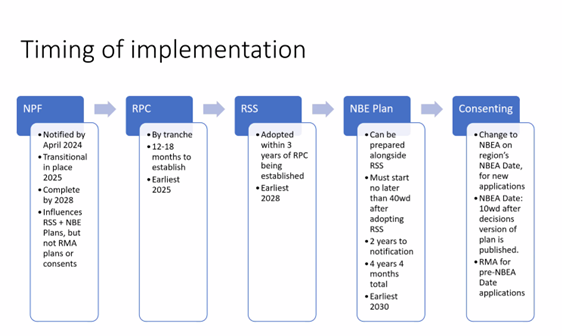Central government is introducing a new planning regime to replace the Resource Management Act 1991 (RMA)- three new Acts which aim to improve the efficiency and effectiveness of the system. There has been significant progress made since the reform was first suggested – this blog will provide a useful summary of where the resource management reform is up to in September 2023.
What is resource management reform?
The RMA will be replaced by the three Acts:
- Natural and Built Environments Act (NBEA) – This will be the main replacement for the RMA.
- Spatial Planning Act (SPA),
- Climate Adaptation Act (CAA).
We have discussed the resource management reform in our previous blog series, you can find the blogs here and here. We will look at more details of the Acts in the coming weeks.
What’s new?
Central government introduced the Natural and Built Environments Bill and Spatial Planning Bill into parliament in November 2022. On 16 August 2023, the Natural and Built Environment Act 2023 (NBEA) and the Spatial Planning Act 2023 (SPA) passed their third reading and were given royal assent, with both coming into effect from 24 August 2023. This means that the bills officially pass into law, and some parts of the two Acts will take effect from this date. Whilst the Natural and Built Environment Act and Spatial Planning Act will replace the RMA, the complete transition to the new planning system is expected to take over a decade, with it being rolled out in “tranches” over different regions at a time, and moving from higher level plans, down to more specific NBE plans.
There will be very few immediate changes.
What’s in the RM reform?
Before moving on to the discussion on when the new planning system is expected to fully roll out, it’s important to understand what the new system contains.
As part of the RM reform, new Regional Planning Committees (RPC) are required. An RPC will be established for each region, comprising representatives from local government, central government and mana whenua. An RPC will be responsible for the development of the Regional Spatial Strategy (RSS) and NBE plans.
Similar to the current system under the RMA, the new system establishes a hierarchy of planning instruments (where each document must be consistent with the ones above it) as follows:
- National Planning Framework (NPF) – This document will provide direction on matters of national significance, alongside environmental limits and targets, and exceptions to these. You can find out more here.
- Regional Spatial Strategies (RSS) – Each region is required to develop a regional level plan, and it will set out long-term strategic direction for a region and be supported by implementation plans. The implementation plans will set out actions and responsibilities to achieve the RSS direction.
- Natural and Built Environment Plans (NBE Plans) – Natural and Built Environment Plans will replace the regional and district plans under the RMA. The NBE plans will set out outcomes, policies, rules and other methods, which address the new NBEA mechanisms including how environmental limits and targets will be achieved

Source: Ministry for the Environment
What is the timeframe?

The RM reform will roll out sequentially, from a national level (NPF) to a regional level (RSS) and then the NBEA plans. Different regions will have their own timeframes in terms of implementing the NBE Plans. This means the timeframes of NBE Plans could vary significantly by region.
The National Planning Framework is expected to come into effect in early 2025[1]. It will be delivered in stages, with the first relating to natural hazards and resilience. The National Planning Framework will influence the development of Regional Spatial Strategies and Natural and Built Environment Plans.
Once the National Planning Framework becomes operative, the first task for local government is to form the Regional Planning Committee (RPC), this is expected to take 12 to 18 months. The Regional Spatial Strategy will be adopted within 3 years of RPC being established, likely to be completed by 2028.
The NBE plans will not be prepared until the relevant Regional Spatial Strategy (RSS) is in place or could be prepared alongside the RSS. Drafting of the NBE plans must start within 40 working days after the RSS is in place and they must be notified within 2 years of starting. It’s expected that the first NBE plans will be available in 2030 at the earliest- it’s not a quick process!
Slow but steady?
Undoubtedly there will be a long transition before the new planning regime is fully implemented and takes over from the RMA, let alone the other changes happening at the moment that may result in delays in the process.
The upcoming general election on 14 October 2023 will cause further uncertainty and changes to the RM reform. The National Party and the Act Party are vowing to repeal the NBA and SPA by Christmas 2023 if they form a government after the election.
It will be interesting to see what would happen as the RM reform continues.
Want to know more?
If you have any questions about the implications of NBEA or SPA on your project during the transitional period, you can contact us on hello@planningplus.co.nz or (09) 427 9966. Discussing implications with a planner who’s keeping on top of all the proposed changes is more important than ever!
© Planning Plus Ltd 2023
[1] our-future-rm-system-developing-the-npf.pdf (environment.govt.nz)



